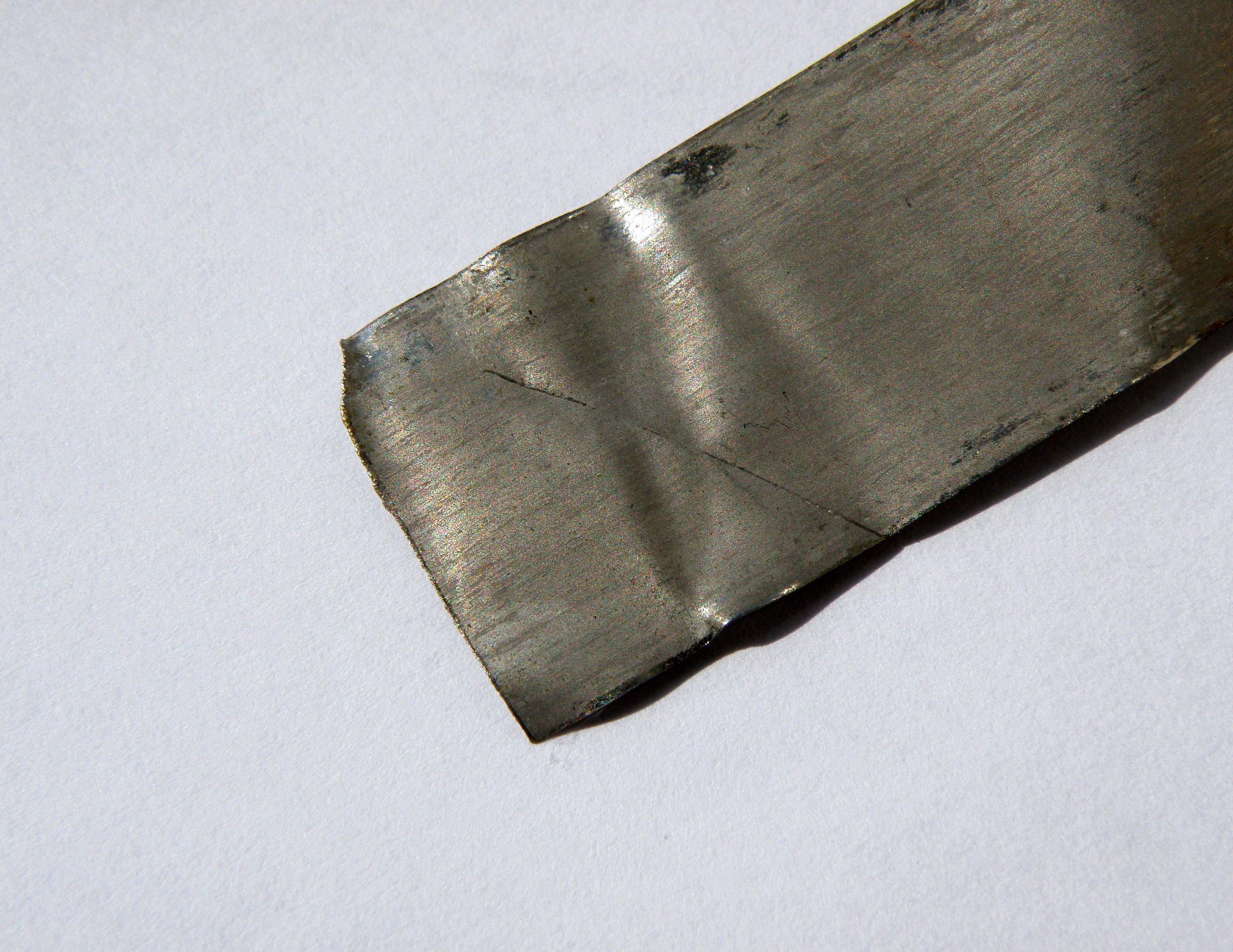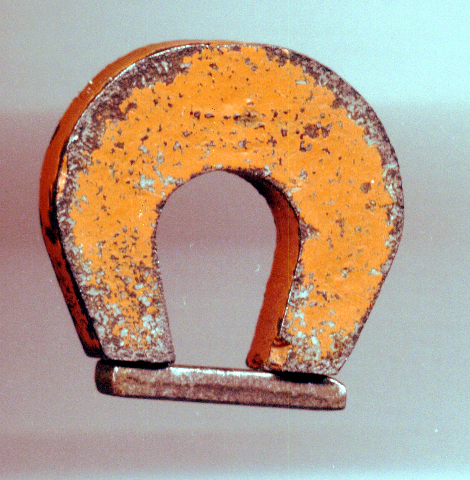|
Magnetic Alloys
A magnetic alloy is a combination of various metals from the periodic table such as ferrite that exhibits magnetic properties such as ferromagnetism. Typically the alloy contains one of the three main magnetic elements (which appear on the Bethe-Slater curve): iron (Fe), nickel (Ni), or cobalt (Co). However, alloys such as Heusler alloys exhibit ferromagnetic properties without any of the preceding 3 elements, and alloys of iron and manganese such as stainless steels may be essentially nonmagnetic at room temperature. Magnetic properties of an alloy are highly dependent not only on the composition but also on heat treatment and mechanical processing. Magnetic alloys have become common, especially in the form of steel (iron and carbon), alnico (iron, nickel, cobalt, and aluminum), and permalloy (iron and nickel). So-called "neodymium magnets" are alloys of neodymium, iron and boron forming the crystal structure Nd2Fe14B. After magnetization, items made out of these alloys will r ... [...More Info...] [...Related Items...] OR: [Wikipedia] [Google] [Baidu] |
Alloy
An alloy is a mixture of chemical elements of which in most cases at least one is a metal, metallic element, although it is also sometimes used for mixtures of elements; herein only metallic alloys are described. Metallic alloys often have properties that differ from those of the pure elements from which they are made. The vast majority of metals used for commercial purposes are alloyed to improve their properties or behavior, such as increased strength, hardness or corrosion resistance. Metals may also be alloyed to reduce their overall cost, for instance alloys of gold and Copper(II) sulfate, copper. A typical example of an alloy is SAE 304 stainless steel, 304 grade stainless steel which is commonly used for kitchen utensils, pans, knives and forks. Sometime also known as 18/8, it as an alloy consisting broadly of 74% iron, 18% chromium and 8% nickel. The chromium and nickel alloying elements add strength and hardness to the majority iron element, but their main function is ... [...More Info...] [...Related Items...] OR: [Wikipedia] [Google] [Baidu] |
Permalloy
Permalloy () is a nickel–iron magnetic alloy, with about 80% nickel and 20% iron content. Invented in 1914 by physicist Gustav Elmen at Bell Telephone Laboratories, it is notable for its very high magnetic permeability, which makes it useful as a magnetic core material in electrical and electronic equipment, and also in magnetic shielding to block magnetic fields. Commercial permalloy alloys typically have relative permeability of around 100,000, compared to several thousand for ordinary steel. In addition to high permeability, its other magnetic properties are low coercivity, near zero magnetostriction, and significant anisotropic magnetoresistance. The low magnetostriction is critical for industrial applications, allowing it to be used in thin films where variable stresses would otherwise cause a ruinously large variation in magnetic properties. Permalloy's electrical resistivity can vary as much as 5% depending on the strength and the direction of an applied magnetic ... [...More Info...] [...Related Items...] OR: [Wikipedia] [Google] [Baidu] |
Ferromagnetism
Ferromagnetism is a property of certain materials (such as iron) that results in a significant, observable magnetic permeability, and in many cases, a significant magnetic coercivity, allowing the material to form a permanent magnet. Ferromagnetic materials are noticeably attracted to a magnet, which is a consequence of their substantial magnetic permeability. Magnetic permeability describes the induced magnetization of a material due to the presence of an external magnetic field. For example, this temporary magnetization inside a steel plate accounts for the plate's attraction to a magnet. Whether or not that steel plate then acquires permanent magnetization depends on both the strength of the applied field and on the coercivity of that particular piece of steel (which varies with the steel's chemical composition and any heat treatment it may have undergone). In physics, multiple types of material magnetism have been distinguished. Ferromagnetism (along with the similar effec ... [...More Info...] [...Related Items...] OR: [Wikipedia] [Google] [Baidu] |
Ferroalloy
Ferroalloy refers to various alloys of iron with a high proportion of one or more other elements such as manganese (Mn), aluminium (Al), or silicon (Si). They are used in the production of steels and alloys. The alloys impart distinctive qualities to steel and cast iron or serve important functions during production and are, therefore, closely associated with the iron and steel industry, the leading consumer of ferroalloys. The leading producers of ferroalloys in 2014 were China, South Africa, India, Russia and Kazakhstan, which accounted for 84% of the world production. World production of ferroalloys was estimated as 52.8 million tonnes in 2015. Compounds The main ferroalloys are: *FeAl – ferroaluminum *FeB – ferroboron – 12–20% of boron, max. 3% of silicon, max. 2% aluminium, max. 1% of carbon *FeCe – ferrocerium *FeCr – ferrochromium *FeMg – ferromagnesium *FeMn – ferromanganese *FeMo – ferromolybdenum – min. 60% Mo, max. 1% Si, max. 0.5% Cu *Fe ... [...More Info...] [...Related Items...] OR: [Wikipedia] [Google] [Baidu] |
Aerospace
Aerospace is a term used to collectively refer to the atmosphere and outer space. Aerospace activity is very diverse, with a multitude of commercial, industrial, and military applications. Aerospace engineering consists of aeronautics and astronautics. Aerospace organizations research, design, manufacture, operate, maintain, and repair both aircraft and spacecraft. The border between space and the atmosphere has been proposed as above the ground according to the physical explanation that the air density is too low for a lifting body to generate meaningful lift force without exceeding orbital velocity. This border has been called the Kármán line. Overview In most industrial countries, the aerospace industry is a co-operation of the public and private sectors. For example, several states have a civilian space program funded by the government, such as NASA, National Aeronautics and Space Administration in the United States, European Space Agency in Europe, the Canadian Space A ... [...More Info...] [...Related Items...] OR: [Wikipedia] [Google] [Baidu] |
Motors
An engine or motor is a machine designed to convert one or more forms of energy into mechanical energy. Available energy sources include potential energy (e.g. energy of the Earth's gravitational field as exploited in hydroelectric power generation), heat energy (e.g. geothermal), chemical energy, electric potential and nuclear energy (from nuclear fission or nuclear fusion). Many of these processes generate heat as an intermediate energy form; thus heat engines have special importance. Some natural processes, such as atmospheric convection cells convert environmental heat into motion (e.g. in the form of rising air currents). Mechanical energy is of particular importance in transportation, but also plays a role in many industrial processes such as cutting, grinding, crushing, and mixing. Mechanical heat engines convert heat into work via various thermodynamic processes. The internal combustion engine is perhaps the most common example of a mechanical heat engine in which hea ... [...More Info...] [...Related Items...] OR: [Wikipedia] [Google] [Baidu] |
Samarium
Samarium is a chemical element; it has symbol Sm and atomic number 62. It is a moderately hard silvery metal that slowly oxidizes in air. Being a typical member of the lanthanide series, samarium usually has the oxidation state +3. Compounds of samarium(II) are also known, most notably the monoxide SmO, monochalcogenides SmS, SmSe and SmTe, as well as samarium(II) iodide. Discovered in 1879 by French chemist Paul-Émile Lecoq de Boisbaudran, samarium was named after the mineral samarskite from which it was isolated. The mineral itself was named after a Russian mine official, Colonel Vassili Samarsky-Bykhovets, who thus became the first person to have a chemical element named after him, though the name was indirect. Samarium occurs in concentration up to 2.8% in several minerals including cerite, gadolinite, samarskite, monazite and bastnäsite, the last two being the most common commercial sources of the element. These minerals are mostly found in China, the United State ... [...More Info...] [...Related Items...] OR: [Wikipedia] [Google] [Baidu] |
Samarium–cobalt Magnet
Samarium–cobalt (SmCo) magnets belong to the category of rare-earth magnets and are composed of samarium (Sm), a rare-earth element, and cobalt (Co), a transition metal. They are among the strongest permanent magnets. They were developed in the early 1960s based on work done by Karl Strnat at Wright-Patterson Air Force Base and Alden Ray at the University of Dayton. In particular, Strnat and Ray developed the first formulation of SmCo5. Samarium–Cobalt magnets are generally ranked similarly in strength to neodymium magnets, but have higher temperature ratings and higher coercivity. Attributes Some attributes of samarium-cobalts are: * Samarium–cobalt magnets are extremely resistant to demagnetization. * These magnets have good temperature stability maximum use temperatures between and Curie temperatures from to . * They are expensive and subject to price fluctuations (cobalt is market price sensitive). * Samarium–cobalt magnets have a strong resistance to corrosi ... [...More Info...] [...Related Items...] OR: [Wikipedia] [Google] [Baidu] |
Coercivity
Coercivity, also called the magnetic coercivity, coercive field or coercive force, is a measure of the ability of a ferromagnetic material to withstand an external magnetic field without becoming Magnetization, demagnetized. Coercivity is usually measured in oersted or ampere/meter units and is denoted . An analogous property in electrical engineering and materials science, electric coercivity, is the ability of a ferroelectric material to withstand an external electric field without becoming polarization density, depolarized. Ferromagnetic materials with high coercivity are called magnetically ''hard'', and are used to make permanent magnets. Materials with low coercivity are said to be magnetically ''soft''. The latter are used in transformer and inductor magnetic core, cores, recording heads, microwave devices, and magnetic shielding. Definitions Coercivity in a ferromagnet, ferromagnetic material is the intensity of the applied magnetic field (''H'' field) required ... [...More Info...] [...Related Items...] OR: [Wikipedia] [Google] [Baidu] |
Remanence
Remanence or remanent magnetization or residual magnetism is the magnetization left behind in a ferromagnetic material (such as iron) after an external magnetic field is removed. Colloquially, when a magnet is "magnetized", it has remanence. The remanence of magnetic materials provides the magnetic memory in magnetic storage devices, and is used as a source of information on the past Earth's magnetic field in paleomagnetism. The word remanence is from remanent + -ence, meaning "that which remains". The equivalent term residual magnetization is generally used in engineering applications. In transformers, electric motors and generators a large residual magnetization is not desirable (see also electrical steel) as it is an unwanted contamination, for example, a magnetization remaining in an electromagnet after the current in the coil is turned off. Where it is unwanted, it can be removed by degaussing. Sometimes the term retentivity is used for remanence measured in units of m ... [...More Info...] [...Related Items...] OR: [Wikipedia] [Google] [Baidu] |
Magnetization
In classical electromagnetism, magnetization is the vector field that expresses the density of permanent or induced magnetic dipole moments in a magnetic material. Accordingly, physicists and engineers usually define magnetization as the quantity of magnetic moment per unit volume. It is represented by a pseudovector M. Magnetization can be compared to Polarization density, electric polarization, which is the measure of the corresponding response of a material to an electric field in electrostatics. Magnetization also describes how a material responds to an applied magnetic field as well as the way the material changes the magnetic field, and can be used to calculate the forces that result from those interactions. The origin of the magnetic moments responsible for magnetization can be either microscopic electric currents resulting from the motion of electrons in atoms, or the Spin (physics), spin of the electrons or the nuclei. Net magnetization results from the response of a ... [...More Info...] [...Related Items...] OR: [Wikipedia] [Google] [Baidu] |
Neodymium Magnet
A nickel-plated neodymium magnet on a bracket from a hard disk drive file:Nd-magnet.jpg">Nickel-plated neodymium magnet cubes Left: high-resolution transmission electron microscopy image of Nd2Fe14B; right: crystal structure with unit cell marked">crystal structure with unit cell">crystal structure">transmission electron microscopy image of Nd2Fe14B; right: crystal structure with unit cell marked A neodymium magnet (also known as NdFeB, NIB or Neo magnet) is a permanent magnet made from an alloy of neodymium, iron, and boron to form the Nd2Fe14B tetragonal crystal system, tetragonal crystalline structure. They are the most widely used type of rare-earth magnet. Developed independently in 1984 by General Motors and Sumitomo Special Metals, neodymium magnets are the strongest type of permanent magnet available commercially. They have replaced other types of magnets in many applications in modern products that require strong permanent magnets, such as electric motors in c ... [...More Info...] [...Related Items...] OR: [Wikipedia] [Google] [Baidu] |







